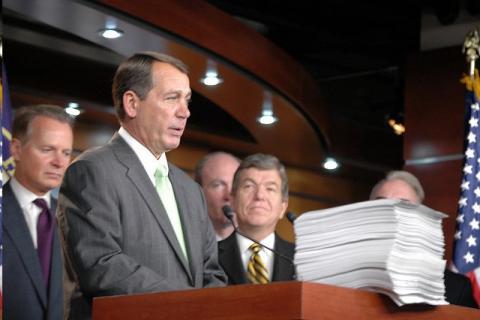The Rise and Fall of the Republican Party

Open with: Mitt Romney and Paul Ryan watch on as Obama is sworn in. Cut to: Republican strategists pour over election results and label 2013 a much-needed rebranding year. Cut to: An autopsy report is released on the GOP brand encouraging Republicans to lose the "stuffy old men" image. Cut to: Young college Republicans perform an autopsy report of their own. Respondents criticize the Republican party as bigoted and essentialist. Cut to: Nevada GOP leader saying 2014 will be a good year for Republicans because minorities and young voters won't turn out. Cut to: Ted Cruz reading Green Eggs and Ham to his kids while the government shutdown looms. Cut to: Government shutdown and a Republican party at war with itself. Cut to: A tan and battle-worn John Boehner standing at the pulpit wearing a salmon-orange tie with circle-and-a-dot patterns distributed in white. Finish with: 2013 and the year of the Republican civil war.
The history of the Republican Party isn't as stagnant as today's representatives indicate. Like most (well, some) political movements, the GOP began with good intentions. At its genesis, the Republican Party coalesced in opposition to popular sovereignty, Stephen Douglass and the Kansas-Nebraska Act of 1854. Populated by Whigs, Free-Soilers and anti-slavery coalitions, the Republican Party, once formed, became the North's foil to the Southern-backed Democrats. Within five years, the yearling party was in control of a staggering majority of Northern state and federal offices on the platform of "free labor, free land, free men" and within six years time, the party had their first president in the White House: Abraham Lincoln.
As the Civil War came to an end and post-bellum reconstruction no longer carried political weight (and fell subject to corruption), the Republican party mobilized to support the massive industrialization underway in the North, pushing for fast growth with laissez-faire economics. Their support of the fast economic expansion and high wages continued through (and helped bring about) the Great Depression, which brought Republican momentum to a screeching halt. Quickly thereafter, the GOP succumbed to a revamped Democratic party and FDR's New Deal, introducing a realignment of each party's ideologies. In response to their ousting, Republicans condemned the New Deal as poorly veiled socialism and gravitated toward a new domestic policy of conservatism.
The platform stuck with American voters and conservatism became the party's new rallying flag. By intermingling their pro-business roots and right-wing social policies, the Republican Party indoctrinated the now aging vanguard of the GOP's constituents, the renowned Greatest Generation. Today, the Republican Party still supports big business and social conservatism, but the party defines their brand more frequently through social policies, an agenda that is beginning to fall out of touch with the younger Republicans and American public opinion. The disparity between party agenda and public interest led to the now famous (infamous?) autopsy report after Mitt Romney's and Paul Ryan's defeat.
Post-Romney/Ryan defeat, Republicans ordered an autopsy report on their '12 campaign season. The report, entitled the Growth and Opportunity Project exposed several large anachronisms and rifts in the party. To quote directly from the report: "These are voters who recently left the Party [sic]. Asked to describe Republicans, they said that the Party is 'scary,' 'narrow-minded,' and 'out of touch" and that we were a Party of 'stuffy old men.' This is consistent with the findings of other post-election surveys." The report continues, encouraging the "Party" to reconsider its position on immigration, gay marriage and corporate welfare, all positions the party has taken staunchly conservative and vocal positions on. The autopsy reporters don't outright criticize the party's backward politics but the message is clear: Change or get left behind.
The autopsy extensively studied the relationship between young voters and Republicans, urging Republicans to not ignore young voters. In response, the Young College Republicans took it upon themselves to find out what it would take to staunch the young voter hemorrhage. Their report (Grand Ole Party for a Brand New Generation) is equally critical of the current status of the GOP and advocates as radical (if not more so) a transformation.
Seducing the youth
The Republican party suffers consistently from its inability to update their policies in sync with the social zeitgeist. While Democrats are conveniently positioned to write off any of its Biden-esque outbursts as impassioned, filled-with-the-spirit-of-civil-liberties idealization, Republicans’ outspoken foot-in-mouth occurrences submit the party to accusations of exclusivity, bigotry, and sexism. The social mantle that Republicans appear hellbent on upholding has wedded their policies with that of the oppressor, making moments like Rick Perry vs. Wendy Davis, Todd Akin on rape, or Pat Hickey on minorities and young voters so injurious to the party's image and a reflex foe of the educated youth.
Romney/Ryan lost the young vote by 5 million, an impressive number when considering the popular vote was decided by < 5 million. In response to this deficit, the Republican party quickly pledged to rework the party's appeal and entice young voters back to the fold. From the autopsy: "This is not a unique take—the general view of Republicans is that Obama’s success with young voters is a product of some intrinsic “cool” he possesses. If the GOP can mimic that cool, the argument goes, then they’ll make inroads with young people." Something about "stuffy old men" learning how to "mimic that cool" from America's black president strikes a pleasant note on the funny bone. Coolness might be a Sisyphean feat for Republicans; however, young Republicans are confident their party can "make inroads" by amending some of their more antiquated policies. And for many young Republicans, this means a radical shift on social issues.

Alex Smith, National Chair of the College Republican National Committee, was asked by party leaders to meet and discuss committee findings as detailed in Grand Ole Party for a brand new generation. She reports that she found her party's leaders to be receptive, but hesitant to change their platforms at the risk of losing their core constituency. However, college Republicans, said Smith, quickly took to the new direction and echoed the desire for their party to practice tolerance in regards to social issues such as gay marriage, abortion and cannabis legalization. For these young Republicans, the party needs to explain "what we are for and not just what we are against." The Republican party tendency to self-define through negation (Republicans are often referred to as the "party of no") doesn't provide a clear message for young voters. Smith believes that by removing emphasis on social issues and introducing more diversity into the party while maintaining nonsocial conservative platforms (fiscal conservatism, namely), Republicans would begin to close the 5 million youth vote gap.
Republicans received the autopsy in March 2013 and the College Republican follow-up in June, which resulted in widespread party dialogue about reworking the brand image according to the findings in both reports. Now, nearly half a year later and a year out from mid-terms, the Grand Ole Party status quo prevails.
The Republican race against time
A large consortium of Republicans’ core constituency falls under (or is fast approaching) the 65 and older demographic, retirees concerned with the solvency of entitlement programs that identify with the socially conservative platforms Republicans touted for many years. Needless to say, these foundations are a bit fragile and don't strengthen the Republican party’s prospects in the future. The other core group, hardline Christians, hinders Republican rebranding by refusing to yield on subjects such as gay marriage or abortion. If candidates opt to pander to evangelicals (as many 2016 GOP hopefuls already have) and aged Foxed News enthusiasts (ditto) then they run the risk of seeming too conservative to moderates, a voter demographic no presidential candidate can afford to ostracize themselves from.
In addition, the Republican party must mind their donors and constituency. Since campaign donors and constituents predated both the autopsy and YCR report, changing social policy may mean losing campaign dollars and votes (something, frankly, many Republicans cannot afford). Like venture capitalists choosing a profit-turning startup over an undeveloped startup with higher potential, Republican representatives are more apt to opt for the pre-established constituency instead of risking a potentially high-yielding voter demographic (the Hispanic vote) at the expense of alienating their base. While continuing to rely on the core constituency and creative gerrymandering (an outdated term, maybe Bachmanning is more appropriate) suffices for Republican policymakers currently in office, it does a tremendous disservice to the generation looking to follow in their footsteps.
And so, the Republican party finds themselves at a grim rebranding crossroads, where Inactivity seriously harms the future prospects of the party.
Republican Party, Tea-Stained
The largest thorn in the considerably pricked Republican party machine's side has to be the Tea party. The Tea party grew out of proposed budget cuts for Medicare in 2009 (or out of the ashes of Ron Paul's 2008 presidential campaign) and has morphed into a party that enjoys pitting the rights of the aged against the rights of the youth among various other snipe-style political stunts. Tea party members ape libertarian ideals of limited government and spending (yet they ardently fight for Medicare and senior entitlement programs) but otherwise lack any solid identity, posing more as a decentralized movement than a party adhering to a strict agenda. What the various splinters of the Tea party do agree on is governance in harmony with the Constitution and unspoken qualifications for membership: White, male, god-fearing, married and over the age of 55.

The Tea party is conventionally viewed as the small, more radical component of the Republicans, but lately, Tea party members are pitting themselves against the Republican establishment with candidates of their own and they have some significant financial backers. Now, Majority Leader Boehner and the established Republican party members face an additional obstacle when it comes to keeping up the longstanding prominence of the Republican party. Large corporations are stepping in to assist with the battle against the rabid Tea party faction, but this rift within the party is sparking major concern in younger party donors who fear omens of a house divided. Now, as the party begins to show signs of volatility at the doorstep, many regular Republican donors are balking or hedging their bets
Heritage action defects
Since the Reagan administration, the Heritage Foundation functions as a policy influencing vehicle for conservative corporate agendas; it continues in this capacity today. As of late, the Heritage Foundation assumed a more conservative stance, attacking Republicans who were (purportedly) too close to the center and not representative of true Republican conservatism. To the surprise of no one, the Heritage Foundation and their advocacy branch, Heritage Action, have recently aligned themselves with the Tea party, placing one of their most vocal members, ex-Senator Jim DeMint, at the Foundation's helm in 2012.
To add to Boehner's Republican woes, the Heritage Action has resorted to smear campaigns against Republicans that haven't observed the Heritage's metric for adequate conservatism, especially in regards to Obamacare. More than 100 house Republicans found themselves in the Heritage's crosshairs, an act which, for many GOP staffers, borders on party insurrection.
However, not all Republicans suffer under Heritage Action's bullying. According to the Heritage Action scorecard, several hyper-conservative Republicans receive top marks. On top of the scorecard sits Tea party mascot Senator Ted Cruz, with a perfect score (4 percentage points higher than the other 2016 hopeful, Rand Paul). Whether Sen. Cruz dictates the Heritage Action's scorecard or Heritage Action dictates Sen. Cruz is fodder for Maddow, but what does rate, however, is the serious backing given to an oft-swatted gadfly like Sen. Cruz, a political figure whom many write off as a charlatan without any presidential contender clout (of course, many others point at the showdown between Cruz and Boehner as the reason for the expensive government shutdown).
Heritage Action's power play is another omen of inner-party strife. Not only is the Tea party threatening to bring down the Republican establishment from within, one of the Republican party's most famous and most influential backers has defected to join the ranks of their destroyers. The Heritage/Tea party assault turns rebranding into a gamble if one considers that a Republican rebranding (and inevitable break from the Tea party) may result in losing their core constituents to Cruz and company, effectively splitting the conservative vote. It's quite the dilemma: How can Republicans avoid losing their base to their more conservative counterparts and still garner enough support to overcome the Democrats?

Is this goodbye?
What remains certain as Senator Ted Cruz props himself up during the 21st hour of his filibuster, preparing his anti-Obamacare closing statements and basking in the ire of his party members, is that the Democrats are in control. Blame for the government shutdown shifted onto the Republicans and while Democrats quietly toe their party lines, Republicans are venturing dangerously close to a boiling point. Although the Democrats aren't without their flaws (unpopular movement against Syria and NSA leaks have flung the Dems into their share of political imbroglios), the Republican party is too immersed in suturing their own inner-party rifts to benefit from Democratic failures.
Five months after the two reports were released and the Republican party finished licking their 2012 wounds, the GOP has not adjusted to the prognosis of their advisors, strategists and youth. Instead, Boehner seems to be steering his party into the center of the square, with the Tea Party and Heritage Foundation pulling on the party's legs and old donors and youth pulling on their hands. If the Republican party doesn't find some way to fight those that pull and reassemble the troops, they may find themselves quartered.
Author Bio:
Tyler Huggins is a contributing writer at Highbrow Magazine.
Photos: House GOP Leader (Flickr); Donkey Hote (Flickr); Jackie M. Barr (Flickr).





























































































































































































































































































































